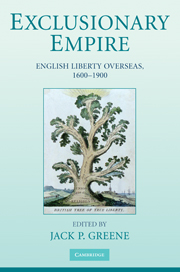Book contents
- Frontmatter
- Contents
- Notes on Contributors
- Preface
- Introduction
- 1 The Languages of Liberty in British North America, 1607–1776
- 2 Liberty and Slavery
- 3 “Era of Liberty”
- 4 Liberty and Modernity
- 5 Federalism, Democracy, and Liberty in the New American Nation
- 6 Liberty, Order, and Pluralism
- 7 Contested Despotism
- 8 “… a bastard offspring of tyranny under the guise of liberty”
- 9 How Much Did Institutions Matter?
- 10 The Expansion of British Liberties
- Index
Introduction
Empire and Liberty
Published online by Cambridge University Press: 05 June 2012
- Frontmatter
- Contents
- Notes on Contributors
- Preface
- Introduction
- 1 The Languages of Liberty in British North America, 1607–1776
- 2 Liberty and Slavery
- 3 “Era of Liberty”
- 4 Liberty and Modernity
- 5 Federalism, Democracy, and Liberty in the New American Nation
- 6 Liberty, Order, and Pluralism
- 7 Contested Despotism
- 8 “… a bastard offspring of tyranny under the guise of liberty”
- 9 How Much Did Institutions Matter?
- 10 The Expansion of British Liberties
- Index
Summary
The “birthrights and privileges of Britons,” the agricultural writer Arthur Young declared in 1772, “form a system of liberty, so happily tempered between slavery and licentiousness, that the like is not to be met with in any other country of the globe.” Widely shared by Young's contemporaries, this claim had a long genealogy – and enormous staying power. Rooted in a jurisprudential tradition that emphasized the role of law as a restraint on the power of the Crown, it dated back to such older writings as Sir John Fortescue's De Laudibus Legum Angliae, written during the fifteenth century and always familiar to the English law community but not published until 1616, and to the early seventeenth-century writings of Sir Edward Coke, Sir John Davies, Nathaniel Bacon, and others who elaborated on Fortescue in a series of learned works. Writing in an age when, except for the Netherlands, every other major European state was slipping into absolutism and when England's first two Stuart kings seemed to be trying to extend the prerogatives of the Crown and perhaps even to do away with Parliaments in England altogether, these early seventeenth-century legal writers all were eager to erect legal and constitutional restraints that would ensure security of life, liberty, and property against such extensions of royal power.
This early modern jurisprudential tradition rested on a distinction, already fully elaborated by Fortescue, between two fundamentally different kinds of monarchies that Fortescue called regal monarchy and political monarchy.
- Type
- Chapter
- Information
- Exclusionary EmpireEnglish Liberty Overseas, 1600–1900, pp. 1 - 24Publisher: Cambridge University PressPrint publication year: 2009
- 1
- Cited by



